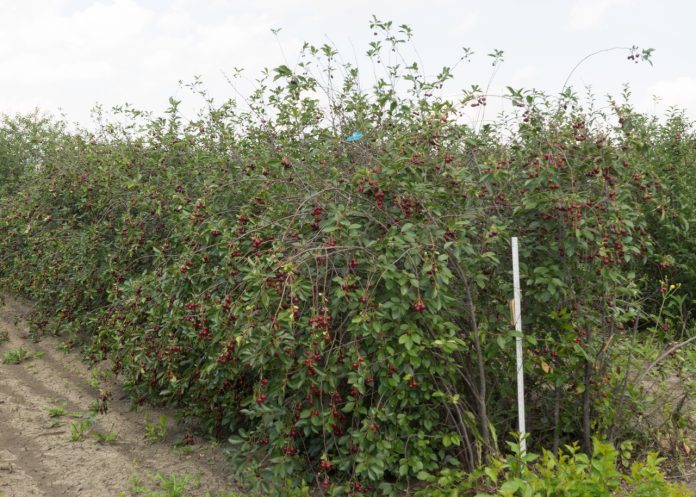Sara Williams
Saskatchewan Perennial Society
Also called pie cherries, these are most often used in cooking and processing. Traditionally, Canadians call them “sour” while Americans call them “tart.” regardless of the fact that many of the new ones are sweet enough to eat fresh. The shorter varieties bred at the University of Saskatchewan are referred to as dwarf sour cherries or bush sour cherries.
Sour cherries are believed to be descendants of natural hybrids between sweet cherries (Prunus avium) and Mongolian cherries (Prunus fruticosa). But P. cerasus and P. fruticosa easily interbreed so those two may be the same species.
‘D’Artagnan’ (along with ‘Cutie Pie’ and ‘Sweet Thing’) is one of the latest varieties from the University of Saskatchewan’s fruit breeding program – plants should be available within the next 12 months. Named after the fourth musketeer in Alexandre Dumas’ novel, it is closely related to most of the Romance cherries and has the same parentage as ‘Juliet’, ‘Valentine’, and ‘Crimson Passion’. Considered the best variety for homeowners who want a hedge of cherries, it suckers more readily than those in the Romance series. Because it is propagated on its own roots, the suckers will have the same high-quality fruit as the parent plant. Within a few years, it will fill in the row, forming a hedge of thin, flexible branches. And, it needs far less pruning than other varieties. Not until the plants are about 12 years old is there a need to thin out older branches. (Most of the other varieties need pruning when 7 years old.)
Tested for over 15 years, ‘D’Artagnan’ has had consistent production with superior hardiness to ‘Carmine Jewel’. It is shorter than most of the romance series, reaching only about 6 feet (180 cm) in height while other varieties eventually attain 8 or 9 feet (240-275 cm). The burgundy fruit tastes similarly to ‘Valentine’ and ‘Juliet’. Most years it ripens in early to mid-August.
To form a hedge, plant them about 3 feet (1 m) apart within a 3-foot (1-m) wide row. Mulch well to prevent grass or weed competition. Once suckers appear between the plants, allow them to fill in the rows.
Sour Cherry History 101
In the 1940s, Les Kerr (then superintendent of the PFRA Sutherland Tree Nursery) began hybridizing sour with Mongolian cherries with the goal of developing sour cherries hardy to zone 2. His job description limited his breeding to trees and shrubs useful in prairie shelterbelts. Chastised by his superiors for working with sour cherries, Les went underground. He continued his clandestine cherry breeding, giving his seedlings to various farmer friends for planting out. In 1983, while gravely ill and hospitalized, he met with Dr. Cecil Stushnoff, then head of the Horticulture Department. During that bedside meeting, Les revealed which farmers were maintaining his best seedlings. Les passed away a week later.
Dr. Stushnoff and technician Rick Sawatzky gathered Les’ best selections and relocated them to the University test plots. Les’ hybrids were a great improvement over the Mongolian cherries. By the late 1980s, Rick had begun crossing Les’ best selections with sour cherries from northern Europe with the goal of improving fruit size and flavour. He released ‘Carmine Jewel’ in 1999, just as Dr. Bob Bors became head of the fruit breeding program. Together, Rick and Bob began selecting the cherries that would eventually become the Romance series. These new cherries fulfill, and in some way surpass, Les’ original goal to develop sour cherries hardy to zone 2.
Retired from the University of Saskatchewan, Sara’s most recent book is Growing Fruit in Northern Gardens with Bob Bors. She’s been hosting garden tours for over 20 years – to Great Britain, Ireland, Europe, Turkey and Iceland. Join her for a tour of French gardens this September [Contact Ruth at 1-888-778-2378, www.worldwideecotours.com]
This column is provided courtesy of the Saskatchewan Perennial Society (SPS; saskperennial@hotmail.com ). Check our website (www.saskperennial.ca) or Facebook page (www.facebook.com/saskperennial) for a list of upcoming gardening event
19 C
Prince Albert
Thursday, April 25, 2024


